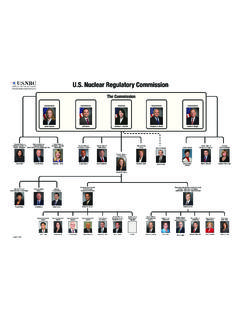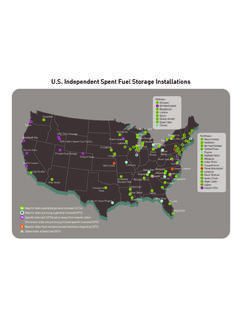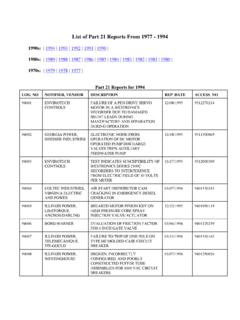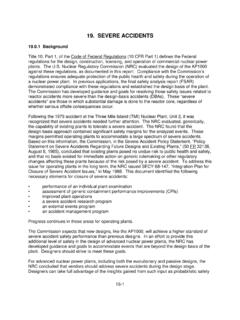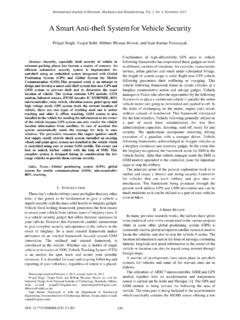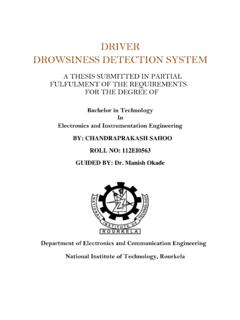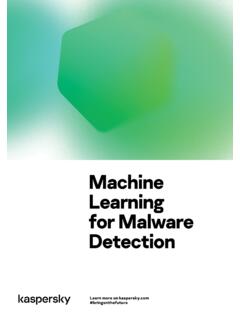Transcription of Cyber Security Assessment Tools and Methodologies for the ...
1 Cyber Security Assessment Tools and Methodologies for the Evaluation of Secure Network Design at Nuclear Power Plants A Letter Report to the NRC January 27, 2012 Prepared by: Cynthia K. Veitch, Susan Wade, and John T. Michalski Sandia National Laboratories Box 5800 Albuquerque, New Mexico 87185 Prepared for: Paul Rebstock, NRC Program Manager Nuclear Regulatory Commission Office of Nuclear Regulatory Research Division of Engineering Digital Instrumentation & Control Branch Washington, DC 20555-0001 NRC Job Code: JCN N6116 Sandia National Laboratories is a multi-program laboratory managed and operated by Sandia Corporation, a wholly owned subsidiary of Lockheed Martin Corporation, for the Department of Energy's National Nuclear Security Administration under contract DE-AC04-94AL85000.
2 Issued by Sandia National Laboratories, operated for the United States Department of Energy by Sandia Corporation. NOTICE: This report was prepared as an account of work sponsored by an agency of the United States Government. Neither the United States Government, nor any agency thereof, nor any of their employees, nor any of their contractors, subcontractors, or their employees, make any warranty, express or implied, or assume any legal liability or responsibility for the accuracy, completeness, or usefulness of any information, apparatus, product, or process disclosed, or represent that its use would not infringe privately owned rights. Reference herein to any specific commercial product, process, or service by trade name, trademark, manufacturer, or otherwise, does not necessarily constitute or imply its endorsement, recommendation, or favoring by the United States Government, any agency thereof, or any of their contractors or subcontractors.
3 The views and opinions expressed herein do not necessarily state or reflect those of the United States Government, any agency thereof, or any of their contractors. i ABSTRACT This report is a survey of Cyber Security Assessment Methodologies and Tools based on industry best practices for the evaluation of network Security and protection of a modern digital nuclear power plant data network (NPPDN) and its associated digital instrument and control (I&C) safety systems. These Methodologies and Tools should be used by Nuclear Regulatory Commission (NRC) staff to evaluate network designs using industry standards, regulatory guidelines, and the technical guidance and acceptance criteria for secure network design developed by Sandia National Laboratories. Additionally, these Methodologies and Tools can be used by NPPDN network administrators, NRC staff, and nuclear power plant owners and operators to evaluate Security and protection throughout the system lifecycle.
4 This report includes a description of the capabilities, limitations, costs, and vendor licensing conditions for technologies presented. Where appropriate, this report explains the operational and Security requirements associated with modern NPPDN and digital I&C safety system design, operation, and maintenance. Additionally, potential repercussions are described that relate to the introduction of the described methodology or tool into a secure nuclear power plant network environment. ii iii CONTENTS ABSTRACT .. i ACRONYMS AND ABBREVIATIONS .. v 1 INTRODUCTION .. 1 Background .. 1 Scope and Purpose .. 3 Report Structure .. 4 2 Cyber Security Assessment .. 5 system Lifecycle .. 5 system Characteristics .. 8 Roles and Responsibilities .. 9 Assessment Methodologies and Tools .. 10 3 NETWORK SCANNING.
5 13 Considerations .. 13 Tools .. 14 4 VULNERABILITY SCANNING .. 17 Categories of Vulnerabilities .. 17 Policy and Procedure Vulnerabilities .. 17 Platform Vulnerabilities .. 18 Network Vulnerabilities .. 20 Considerations .. 21 Tools .. 24 5 PASSWORD CRACKING .. 29 Considerations .. 29 Tools .. 30 6 LOG REVIEW AND ANALYSIS .. 33 Considerations .. 33 Tools .. 34 7 FILE INTEGRITY CHECKING .. 37 Considerations .. 37 Tools .. 37 8 MALWARE detection .. 41 Considerations .. 41 Tools .. 42 9 WAR DIALING .. 45 Considerations .. 46 Tools .. 46 iv 10 WIRELESS TESTING .. 49 Considerations .. 49 Tools .. 50 11 PENTRATION TESTING .. 53 Considerations .. 54 Tools .. 55 12 SUMMARY RECOMMENDATIONS .. 59 13 REFERENCES .. 63 APPENDIX A: Summary of Assessment Methodologies and Recommended 65 APPENDIX B: Map of Tools and Assessment Methodologies .
6 69 FIGURES Figure 1. Hypothetical digital plant system network architecture.. 2 Figure 2. Hypothetical NPPDN with IDS and IPS sensor placements.. 33 TABLES Table 1. Preferred network Assessment activities for high-reliability systems.. 14 Table 2. Sample network scanning Tools .. 16 Table 3. Preferred vulnerability Assessment activities for high reliability systems.. 23 Table 4. Sample vulnerability scanning Tools .. 26 Table 5. Sample password cracking Tools .. 31 Table 6. Sample log review and analysis Tools .. 35 Table 7. Sample file integrity checking Tools .. 39 Table 8. Sample malware detection Tools .. 44 Table 9. Sample war dialing Tools .. 47 Table 10. Sample wireless testing Tools .. 52 Table 11. Sample penetration testing Tools .. 56 v ACRONYMS AND ABBREVIATIONS ACL access control list C&A certification and Assessment CDA critical digital asset CIO chief information officer CLI command line interface COTS commercial-off-the-shelf CSO chief Security officer DCS distributed control system DHCP Dynamic Host Configuration Protocol DI&C digital instrumentation and control DNS Domain Name Service DoS denial of service DSS digital safety system EMP electro-magnetic pulse FISMA Federal Information Security Management Act GUI graphical user interface HMI human-machine interface I&C instrument and control ICS industrial control system ID
7 Identification IDS intrusion detection system IEEE Institute of Electrical and Electronics Engineers IP Internet Protocol IPS intrusion prevention system IT information technology NERC North American Electric Reliability Corporation NIC network interface card NIST National Institute of Standards and Technology NPP nuclear power plant NPPDN nuclear power plant data network NRC Nuclear Regulatory Commission vi OPC OLE for Process Control OS operating system PBX Private Branch Exchange PCS process control system PLC programmable logic controller PSTN public switched telephone network RAS remote access server RG Regulatory Guide RTOS real-time operating system RTU remote terminal unit SCADA supervisory control and data acquisition SNL Sandia National Laboratories SP Special Publication SSID service set identifier VoIP voice-over-IP WEP Wired Equivalent Privacy protocol WLAN wireless local area network 1 1 INTRODUCTION Cyber Security Assessment consists of methods and procedures used to assess
8 The effectiveness of Cyber Security controls in a digital system . In particular, the Assessment methods and procedures are used to determine if the Security controls are implemented correctly, operating as intended, and producing the desired outcome with respect to meeting the Security requirements of the asset owner. Cyber Security Assessment is one of the most reliable methods of determining whether a system is configured and continues to be configured to the correct Security controls and policy. The Assessment Methodologies and Tools described in this document are meant to assist nuclear power plant owners, operators, and network administrators in keeping their systems operationally secure and as resistant as possible to attack. Nuclear Regulatory Commission (NRC) staff should use the techniques described herein to evaluate secure network designs using industry standards, regulatory guidelines, and the technical guidance and acceptance criteria.
9 These Assessment activities, if made part of standard system and network administration and Assessment , can be highly cost-effective in preventing incidents and uncovering vulnerabilities. Background Nuclear power plant data networks (NPPDNs) and their associated safety systems are being modernized to include many information technology (IT) networks and applications. Along with the advancement of plant data networks (PDNs), instrument and control (I&C) systems are being upgraded with modern digital, microprocessor-based systems. These systems provide a high degree of automation to enhance plant operation, reduce operator burden, and improve situational awareness during normal and off-normal conditions. However, these same systems introduce challenges for the nuclear power industry and NRC staff, who are responsible for ensuring the new systems meet all reliability, performance, and Security requirements.
10 Digital I&C systems, such as process control and safety systems, rely on the NPPDN the essential backbone of a secure nuclear power plant (NPP) network design. Figure 1 displays a hypothetical NPP s modern and integrated data and communications architecture. The NPPDN must be highly reliable, maintainable, and independent to ensure that all digital I&C systems will perform their particular missions. Additionally, that network must also support a necessary data bandwidth for conveying system -operational information to the user. Many of the differences between NPPDN architectures and traditional information processing system architectures stem from the fact that logic executing on an NPPDN can have a direct effect on the physical world [2]. These differing characteristics include the potential for significant risk to the health and safety of human lives, serious damage to the environment, and serious financial issues, such as production losses and negative impact to the nation s economy.

